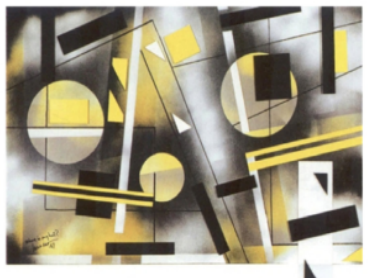Resulting from the trauma of cerebral cortex, cerebral achromatopsia is a special form of color-blindness that is subtly different from other kinds of color-blindness. However, such subtle difference is indispensable since the cortical damage it involves is from infarction of a specific area in the ventral occipitotemporal cortex of humans which always results in injury or illness. It is produced by lesions on the inferior surface of temporo-occipital regions as the picture below indicated.

The reason why I decided to bring this exciting topic up is that this condition is quite unusual and interesting. Although our rods and cones receive the color signals, the color vision can be completely formed only when our occipital cortex captures such signals. Patients who suffer from cerebral achromatopsia lose their ability to partially see or completely identify colors and have strokes in their visual cortex of the brain. Usually, they cannot see colors but are taught ‘what color is what’. As a result, “patients may often not notice their loss of color vision and merely describe the world they see as being ‘drab’, most describe seeing the world in “‘shades of grey’” (Jaeger et al. 1988). This observation notes a key difference between cerebral and congenital achromatopsia, as those born with achromatopsia have never had an experience of color or grey.

One of the most famous examples of cerebral achromatopsia is that of “Jonathan I.”, immortalized in a case study by Oliver Sacks and Robert Wasserman, and later published as “The Case of the Colorblind Painter”. The paper focuses on Mr. I, a painter with cerebral achromatopsia from a car accident. The accident injured his occipital lobe, damaging his ability to perceive colors. Fortunately, Mr.I still retained an awareness of color when his world was only constituted by black and white. In the case study, Sacks recorded this patient’s subsequent struggles from the adaptation of black, white and grey world, how he reinvented his identity as an artist, and how he finally embraced and even appreciated his condition.
For Mr. I, the sense of color was indispensable to his art achievement and artist identity. The loss of color vision was especially traumatizing since he not only had to adjust to a new physical reality, but also accepted this condition from his mental perspective. “My vision was such that everything appeared to me as a black and white television screen … my vision became that of an eagle – I can see a worm wiggling a block away. The sharpness of focus is incredible. But – I AM TOTALLY COLOR-BLIND” (Lawley 1994) he said hopelessly to the scientist.
However, in such difficulties, Mr. I still met his real breakthrough from a sunset. Instead of focusing on its grayness, he perceived the commonly-viewed sunset as a nuclear explosion. He realized that this is his unique way of depiction of sunset. His sense of loss at the lack of color in his world began to disappear. He stopped focusing on what he had lost, although he continued to prefer going out at night, when his vision was similar to normally-sighted people. (Sacks 1996)
Gradually, Mr. I began to treat his cerebral achromatopsia as part of, or even the most unique and significant part of his self-identity. His art completely reflected this transition of his mental perception. Picture one was one of his artworks before the accident. It was obvious that there were few bold lines and chaotic colors shifted into each other. However, after his accident and as he became comfortable with his changed vision, Mr.I’s artwork changed profoundly. From the second picture, we are able to see that his painting consisted of more geometric elements and greater attention were put to detail. Besides, his use of color was more economical and carefully considered.


Source: cleanlanguage.co.uk
The effect is bold and confident, reflecting Mr. I’s faith in himself. According to art critics, this artwork is even better than Mr. I’s previous works. Everyone is different. In the same way some people focus more on composition than content in a piece of art, people who are colorblind will notice different elements. I was astonished by his work when visiting an unknown art museum few years ago. The trauma that contributes the cerebral achromatopsia, was an illness before I perceived such masterpiece. After appreciation for his work, I began to reevaluate this special illness and regard it as the key for a second version of our world that filled with hidden treasure for those struggle in difficulties and is aesthetically valuable for all human beings.

Work Cited
Kwon JS, Yoon DY, Hyun Jeong Han, Jong Ho Park. 2013. Cerebral Achromatopsia After Posterior Cerebral Artery Infarction. undefined. [accessed 2021 May 3]. https://www.semanticscholar.org/paper/Cerebral-Achromatopsia-After-Posterior-Cerebral-Kwon-Yoon/15a4314c48dd76c0d4fd3a5244b5be323864024c.
Jaeger W, Krastel H, Braun St. 1988. Cerebrale Achromatopsie (Symptomatik, Verlauf, Differentialdiagnose und Strategie der Untersuchung). Klinische Monatsblatter fur Augenheilkunde. 193(12):627-634. doi:10.1055/s-2008-1050309. [accessed 2021 May 3]. https://pubmed.ncbi.nlm.nih.gov/3265459/.
Cerebral Achromatopsia & Color Vision. 2016. Eyedoctomnet. [accessed 2021 May 3]. https://eyedoctom.net/subconjunctival-hemorrhage/cerebral-achromatopsia.
Sacks, Oliver. “The Case of the Colorblind Painter”. An Anthropologist on Mars. New York: Random House, 1995. https://oliversacks.tripod.com/james.html.
Vision is Not Black and White: The Colourless Case of Mr. I. 2021. Cleanlanguagecouk. [accessed 2021 May 3]. https://cleanlanguage.co.uk/articles/articles/119/1/Vision-is-Not-Black-and-White-The-Colourless-Case-of-Mr-I/Page1.html.